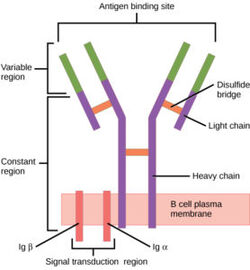Sandbox Reserved 1771
From Proteopedia
| Line 8: | Line 8: | ||
===Antigen Binding Site=== | ===Antigen Binding Site=== | ||
| + | [[Image:B cell diagram.jpg| 250 px| thumb|right|'''Figure 1.''' Overview of the human B Cell Receptor and its structural components. Used with permission under Wikimedia Commons.]] | ||
| + | The binding of an antigen to the human B Cell receptor is identical to other common soluble antibodies (such as [https://en.wikipedia.org/wiki/Immunoglobulin_G IgG], [https://en.wikipedia.org/wiki/Immunoglobulin_A IgA], [https://en.wikipedia.org/wiki/Immunoglobulin_M IgM], [https://en.wikipedia.org/wiki/Immunoglobulin_E IgE], or [https://en.wikipedia.org/wiki/Immunoglobulin_D IgD]). The antibody portion of the B Cell Receptor is roughly "Y" shaped and consists of two identical <scene name='95/952701/Heavy_chains_highlight/2'>heavy</scene> and two identical <scene name='95/952701/Light_chains_highlight/3'>light</scene> chains creating two similar epitope or binding regions. Thus, two antigen molecules can bind independent of one another to produce a response. Within this structure, there are both constant and variable regions. The stem of the "Y" is a <scene name='95/952701/Constant_stem/1'>constant region</scene> ([https://en.wikipedia.org/wiki/Antibody#CDRs,_Fv,_Fab_and_Fc_Regions Fc]) composed of only heavy chain interactions. The two heavy chains then branch at a flexible <scene name='95/952701/Hinge/1'>hinge region</scene>. These interact individually with one light chain creating two [https://en.wikipedia.org/wiki/Antibody#CDRs,_Fv,_Fab_and_Fc_Regions Fab] fragments or branches of the "Y". Each <scene name='95/952701/Fab/1'>Fab fragment</scene> additionally contains a <scene name='95/952701/Fv_region/1'>variable region</scene> ([https://en.wikipedia.org/wiki/Antibody#CDRs,_Fv,_Fab_and_Fc_Regions Fv]) and a <scene name='95/952701/Fab_constant/1'>constant region</scene>. The variable region sits on top of the constant region and consists of hyper-variable loops which are random coils of amino acids that are unique to an antibody and exposed to allow specific recognition of an antigen. Furthermore, the light chains interact with the heavy chains via weak intermolecular forces and disulfide bridges. Therefore, binding to an antigen is processed through intermolecular interactions and is specific due to unique hyper variable loop sequences. | ||
===Fc and α/β Interactions=== | ===Fc and α/β Interactions=== | ||
Revision as of 21:09, 29 March 2023
| This Sandbox is Reserved from February 27 through August 31, 2023 for use in the course CH462 Biochemistry II taught by R. Jeremy Johnson at the Butler University, Indianapolis, USA. This reservation includes Sandbox Reserved 1765 through Sandbox Reserved 1795. |
To get started:
More help: Help:Editing |
Contents |
IgM B-cell Receptor
Introduction
The human B-cell receptor(BCR) is a complex protein made up of three domains: extracellular, transmembrane, and intracellular. While the extracellular region makes up most of the protein, perhaps the most interesting interactions can be found in the transmembrane domain. Unlike other BCRs, the IgM BCR has a specific heavy chain interaction with the α-β subunit of the protein. BCRs are found on the surface of B-cells as membrane bound proteins (ref). In general the role of BCRs is to bind to foreign antigens and initiate the appropriate immune response.
Structure
| |||||||||||
Function
Once bound to an antigen, BCRs undergo a conformational change in the extracellular region. While the exact conformational change is still not known, it initiates several signal transduction pathways. These pathways are responsible for processing the antigen and initiating the appropriate immune responses. More specifically, the α-β subunit is connected to the phosphorylation of an immunoreceptor tyrosine-based activation motif(ITAM) upon binding. This in turn triggers the activation of kinases downstream that aid in the immune response. BCRs can be oligomeric prior to antigen binding, but once bound become an active monomer.
Medical Relevancy
B-cell Formation
The formation of B-cells occurs in the bone marrow. BCRs are attached to B-cells through the aid of membrane-bound proteins in bone marrow cells. During this process, gene recombination occurs, which allows unique BCRs to become highly specific to different antigens.

